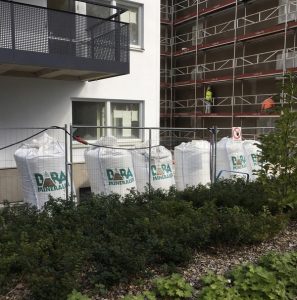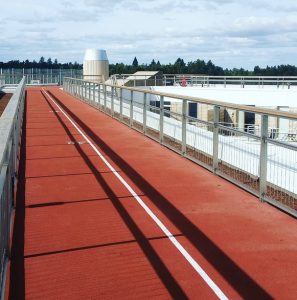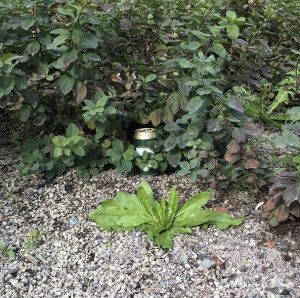In the afternoon of Tuesday of week 2, we had a field ‘excursion’ (or as our course leaders preferred to call it: ‘research lab’), visiting and exploring the pinnacle of ‘green’ urban development of our growing city: southern Rosendal. Uppsala is expanding and the government wishes it to remain within the climate target as it does — by creating an entire district full of modern eco-friendly and community-building buildings.
We took the opportunity to explore it as it is now, half-built, and make our own informal assessment of how eco-friendly and people-friendly we find this new part of Rosendal to be.

It actually looks pretty nice, for being modern architecture.

Some of us expected something a bit simpler, less flashy, and perhaps more nature-inspired, for a green district. But hey, if you think of it as just any other part of a city, for being modern design, it’s not that bad!
The advertised aspects sound and maybe even truly are impressive. Effort has been put into making the actual building process eco-friendly as well as the buildings’ use and maintenance.

There are plenty of areas dedicated to exercise, mostly sport activities. A highly lauded feature was the rooftop running track on one of the buildings. (The city’s largest forest is a stone’s throw away, full of beautiful running and walking tracks… but no, let’s get people running on the roof — really because it’s cool and, as we put it, instagram-friendly.)

Talking to a couple of residents, who did not live here because it was an eco-friendly district, gave us the impression that all the flashy green features weren’t what attracted the residents. If it’s not the appealing part, what impact will it have on the ecological footprint of the area?
A sizeable chunk of the city’s forest was cut down to make room for this district. There is a lot of focus on resource efficiency, through ‘smart’ solutions, but it is well known that food consumption has a way heavier impact on the environment than electricity and water use, and there are no farming spaces or connections to food markets with sustainable goods.
The location — within biking distance of both the SLU campus and the city centre — is heralded as encouraging the use of bikes over cars, yet the parking lots are full. (Caveat: full parking lots could mean the cars aren’t being used, as they are parked.)

There was a blatant scarcity of recycling bins around — even general waste bins were hard to find. Rubbish crept up here and there.


(“Tee-hee, find meeee”…)
Other features struck us as what we called ‘green bling’: green for show.

Look at these bird houses. Right next to the city’s largest forest. Holes too tiny for most birds to comfortably fit through. And… yellow. I wonder what birds would be instinctively drawn to set up a nest inside something this conspicuous.
A lot of Rosendal was impressive at first glance, but after some thought it got rather disappointing. It felt shallow: Instagram-friendly before thought-provoking and life-changing.
A crucial part of sustainable living is adopting sustainable habits. We spoke with one of the residents who admitted she had not considered eco-friendly housing to be important when moving here, yet had made some changes facilitated by the design, and felt good about it. I asked her if living here had inspired her to make any changes toward a sustainable lifestyle beyond what these buildings facilitated, and got a blank face and mind for response.
I sense a risk of residents getting lulled into complacency here. Charmed into feeling good about all the good they’re doing for the environment by living in these proclaimed green apartments, people might tell themselves that this is enough. I hope this brief post has shown that it clearly is not — not by far.
I do still recommend you to visit Rosendal (or a similar green district in your vicinity) yourself, if you are able, and see with your own eyes and judge from your own perception and perspective. Remember, perspective is key.

As you may have noticed, I’m not that big on picture and photo credits. I haven’t taken a single photo on this blog myself, so far. I’m just totally uninterested in who took what photo. But that doesn’t mean I won’t respect it if requested. So if you wonder who took a specific picture, do ask, in a comment below or an email. Or, if you took a picture and want credits for it, also do tell me, and I’ll edit the post to make a note of it.